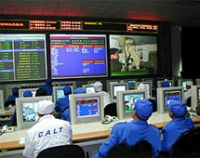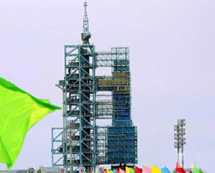Jiuquan
Founded in 1958 in Inner Mongolia the Jiuquan Satellite Launch Center iis China's earliest base and where most launches and tests have been conducted.
It is huge -- about 2,800 square kilometers -- and the climate means that around 300 days each year are suitable for launches. The center is mainly used to send satellites into lower and medium orbits with large orbital inclination angles. It is also capable of testing medium- and long-range missiles. Many groundbreaking launches have been made at Jiuquan.
A visit to Jiuquan
Jiuquan, a small town on north China's deserts, caught worldwide attention in 1970 when China launched its first satellite, and has since developed into a space city with a population of dozens of thousands.
Now, Jiuquan is known as the starting point of China's "Space Long March".
To visitors' surprise, in the town, local residents enjoy a modern life as convenient as those who live in other parts of the country.
In addition to schools, cinemas, sports facilities, restaurants, beauty parlors and shops, there are telephone, TV and Internet services in the city. Visitors can buy souvenirs like the miniature models of rocket carriers and spacecraft.
The town is full of clues that give hints to visitors where they are. One may come up with a street called "Road Space", a hotel with the name of "Sky Flying", and street lamps in the shape of a rocket.
Visitors may also spot numerous pictures of top scientists for China's programs of strategic weapons and space technology.
Only army barracks, the residence of Chinese astronauts and other places guarded by soldiers give a sense of secrecy to outsiders, reminding them that they have come into a place that is different to others.
The Jiuquan Satellite Launch Center, which was built up in 1958,is the only site to project manned vehicles in the country. So far, it has witnessed the launching of 37 satellites and five spacecraft. It is where China launched the first Chinese-made missile, satellite, long-range rocket carrier, rocket carrying three satellites, unmanned spacecraft and manned spacecraft.
At the launch site, there is a workshop where two 58.3 meter-tall Long-March rocket carriers can be assembled at one time. There are two special rails that lead to the launch pad 1,500 meters afar.
The launch site also serves as the first emergency escape area for astronauts and the standby return site for spacecraft, when the main landing site encounters winds at a speed of 15 meters or more per second, or other factors that may prevent aircraft and vehicles from moving to search for returned spacecraft and astronauts.
The search task force at the standby site is composed of four helicopters, three special ambulances and passenger vehicles for astronauts, and a medical team.
If the spacecraft lands in the other parts of the country, aircraft and a parachute squad will be sent for the search. Once the target is found, a large transport plane will fly to an airport close to the target, with three special vehicles of the rescuers aboard.
Jiuquan Launch Records
- June 15, 2010: China launched a space exploration satellite, carried by Long March-2 rocket.
- September 25, 2008: China launched its third manned spacecraft Shenzhou VII, carrying three astronauts. It is the country's first extra-vehicular activity (EVA).
- September 9, 2006: China launched a seed-breeding satellite, "Shijian-8", carrying 215 kilograms of seeds of plants and fungus, the largest-ever such payload since 1987.
- October 12, 2005: China launched its second manned spacecraft Shenzhou VI, sending two astronauts into orbit. It is China's first multi-manned and multi-day space flight and the first human-participated space scientific experiment program.
- August 29, 2005: China sent its 22nd return experimental satellite onto the orbit with a Long March-2IV rocket carrier. The satellite will carry out a series of jobs on scientific research, land surveying, mapping and space-technological tests.
- August 2, 2005: launch of China's 21st return science and technology experimental satellite. It has been the 86th launching of the Long March series rockets, and it is the 44th successful space launch by China since October 1996.
- September 27, 2004: launch of China's 20th recoverable satellite for scientific and technological experiments.
- August 29, 2004: China launched a recoverable science experimental satellite into a preset orbit atop a Long March 2C carrier rocket. It is the 19th recoverable science experimental satellite China has launched.
- October 15, 2003: launch of "Long March 2 F" rocket that sent China's first astronaut Yang Liwei into space in "Shenzhou-5". The next day, after orbiting the earth 14 times, the Yang touched down in central Inner Mongolia. This breakthrough made China the third country in the world capable of independent manned space travel.
- December 30, 2002: launch of another unmanned spacecraft, Shenzhou-4.
- March 25, 2002: unmanned Shenzhou-3 sent into orbit and after circling the earth 108 times, the craft returned on April 1.
- January 10, 2001: launch of Shenzhou-2 experimental spacecraft (re-entry capsule returns to earth six days later in central Inner Mongolia with the results of scientific experiments).
- November 20, 1999: first launch of the experimental Shenzhou spacecraft (the re-entry module landed in central Inner Mongolia Autonomous Region the next day).
- By 1998, 33 satellites had been launched from Jiuquan with a 100 percent success rate. The site has launched more than 1,000 missiles and rockets.
- August 1987: launching services for European aerospace manufacturer Aerospatiale Matra -- China's first involvement in the international space industry.
- May 18, 1980: launch of the first Chinese long-distance carrier rocket.
- November 26, 1975: launch of China's first recoverable satellite.
- April 24, 1970: launch of the first Chinese-made earth satellite.
- October 27, 1966: the country's first guided nuclear missile test.
- November 5, 1960: launch of China's first surface-to-surface missile.

